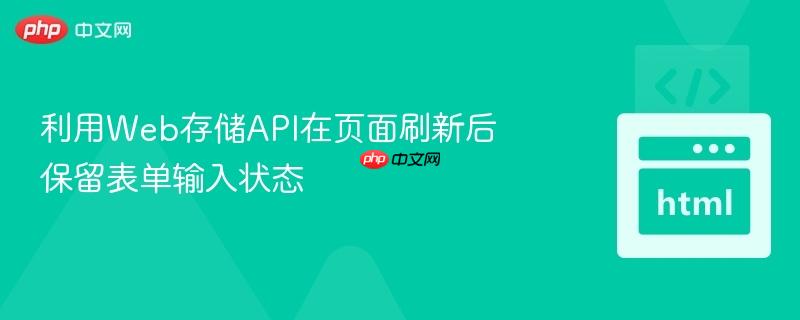
在构建交互式Web应用时,用户体验至关重要。一个常见的问题是,当用户在填写表单但尚未提交时,如果意外刷新页面,所有输入的数据都会丢失。这对于包含大量选择项(如单选按钮组)的表单尤其令人沮丧。为了解决这一问题,我们可以利用客户端存储技术,在浏览器端持久化用户的选择,从而在页面刷新后恢复表单状态。
现代浏览器提供了多种客户端存储机制,允许Web应用程序在用户浏览器中存储数据。这些机制各有特点,适用于不同的场景:
Local Storage是实现跨页面刷新保留表单状态的理想选择,因为它没有过期时间。
假设HTML结构如下,其中name属性是动态生成的,用于标识不同的用户选择组:
<form id="attendanceForm" action="{% url 'create_attendance' baksgewijs.id peloton.id %}" method="post">
{% csrf_token %}
<div class="table-responsive fixed-length">
<table id="userTable">
<tbody>
{% for user in users %}
<tr>
<td> {{ user.name }} </td> {# 假设user对象有name属性 #}
<td>
<div class="form-check">
<input class="form-check-input user-radio" type="radio" name="{{ user.id }}" id="radio-{{ user.id }}-aanwezig" value="Aanwezig">
<label class="form-check-label" for="radio-{{ user.id }}-aanwezig">Aanwezig</label>
</div>
<div class="form-check">
<input class="form-check-input user-radio" type="radio" name="{{ user.id }}" id="radio-{{ user.id }}-afwezig" value="Afwezig">
<label class="form-check-label" for="radio-{{ user.id }}-afwezig">Afwezig</label>
</div>
<div class="form-check">
<input class="form-check-input user-radio" type="radio" name="{{ user.id }}" id="radio-{{ user.id }}-geoorloofd" value="Geoorloofd afwezig">
<label class="form-check-label" for="radio-{{ user.id }}-geoorloofd">Geoorloofd afwezig</label>
</div>
</td>
</tr>
{% endfor %}
</tbody>
</table>
</div>
<input type="submit" value="Sla baksgewijs op" class="btn btn-primary active">
</form>JavaScript 代码:
document.addEventListener('DOMContentLoaded', function() {
const radioButtons = document.querySelectorAll('.user-radio'); // 选取所有带有特定class的单选按钮
// 1. 恢复数据:页面加载时,从Local Storage中恢复之前的选择
radioButtons.forEach(radio => {
const storedValue = localStorage.getItem(radio.name);
if (storedValue && radio.value === storedValue) {
radio.checked = true;
}
});
// 2. 存储数据:监听单选按钮的change事件
radioButtons.forEach(radio => {
radio.addEventListener('change', function() {
if (this.checked) {
localStorage.setItem(this.name, this.value);
}
});
});
// 可选:在表单提交成功后清除相关数据
const form = document.getElementById('attendanceForm');
if (form) {
form.addEventListener('submit', function() {
// 假设表单提交成功后不再需要这些本地存储的数据
radioButtons.forEach(radio => {
localStorage.removeItem(radio.name);
});
// 或者更精细地处理,例如只清除当前表单相关的数据
// 例如:localStorage.clear(); // 清除所有本地存储,慎用
});
}
});注意事项:
Session Storage的用法与Local Storage非常相似,主要区别在于数据的生命周期。它只在当前浏览器标签页或窗口打开期间有效,关闭后数据即被清除。
只需将上述JavaScript代码中的localStorage替换为sessionStorage即可:
document.addEventListener('DOMContentLoaded', function() {
const radioButtons = document.querySelectorAll('.user-radio');
// 1. 恢复数据:从Session Storage中恢复之前的选择
radioButtons.forEach(radio => {
const storedValue = sessionStorage.getItem(radio.name); // 区别在这里
if (storedValue && radio.value === storedValue) {
radio.checked = true;
}
});
// 2. 存储数据:监听单选按钮的change事件
radioButtons.forEach(radio => {
radio.addEventListener('change', function() {
if (this.checked) {
sessionStorage.setItem(this.name, this.value); // 区别在这里
}
});
});
// 可选:在表单提交成功后清除相关数据
const form = document.getElementById('attendanceForm');
if (form) {
form.addEventListener('submit', function() {
radioButtons.forEach(radio => {
sessionStorage.removeItem(radio.name); // 区别在这里
});
});
}
});适用场景:
当数据仅需要在用户当前浏览会话中保持,例如用户在填写一个多步骤表单,但中途需要刷新页面,或者在不同标签页之间切换(如果需要跨标签页则不适用Session Storage),Session Storage是更好的选择。
Cookies可以设置过期时间,使其既可以像Local Storage一样长期存在,也可以像Session Storage一样在会话结束后消失。然而,由于其存储容量小且每次请求都会发送到服务器,通常不建议用于存储大量前端状态数据。对于少量、需要服务器感知的状态(如用户登录令牌),Cookies更为合适。
由于Cookies的API相对复杂,这里提供一个简化的设置和获取函数示例。在实际应用中,通常会使用库(如js-cookie)来简化操作。
// 辅助函数:设置Cookie
function setCookie(name, value, days) {
let expires = "";
if (days) {
const date = new Date();
date.setTime(date.getTime() + (days * 24 * 60 * 60 * 1000));
expires = "; expires=" + date.toUTCString();
}
document.cookie = name + "=" + (value || "") + expires + "; path=/";
}
// 辅助函数:获取Cookie
function getCookie(name) {
const nameEQ = name + "=";
const ca = document.cookie.split(';');
for (let i = 0; i < ca.length; i++) {
let c = ca[i];
while (c.charAt(0) === ' ') c = c.substring(1, c.length);
if (c.indexOf(nameEQ) === 0) return c.substring(nameEQ.length, c.length);
}
return null;
}
document.addEventListener('DOMContentLoaded', function() {
const radioButtons = document.querySelectorAll('.user-radio');
// 1. 恢复数据:从Cookies中恢复之前的选择
radioButtons.forEach(radio => {
const storedValue = getCookie(radio.name);
if (storedValue && radio.value === storedValue) {
radio.checked = true;
}
});
// 2. 存储数据:监听单选按钮的change事件
radioButtons.forEach(radio => {
radio.addEventListener('change', function() {
if (this.checked) {
setCookie(this.name, this.value, 7); // 存储7天
}
});
});
// ... 表单提交后清除Cookies的逻辑类似,使用setCookie(name, "", -1)
});注意事项:
在页面刷新后保留表单输入状态是提升用户体验的关键一环。通过利用Local Storage、Session Storage或Cookies,开发者可以根据数据的生命周期和存储需求,选择最合适的客户端存储方案。对于需要长期保留且不需频繁与服务器交互的表单状态,Local Storage是首选;对于会话级临时数据,Session Storage更为合适;而Cookies则更适用于需要服务器感知的少量状态数据。在实际开发中,结合具体业务场景和数据特性,合理选择并实现数据持久化,将显著提升Web应用的健壮性和用户满意度。
以上就是利用Web存储API在页面刷新后保留表单输入状态的详细内容,更多请关注php中文网其它相关文章!

每个人都需要一台速度更快、更稳定的 PC。随着时间的推移,垃圾文件、旧注册表数据和不必要的后台进程会占用资源并降低性能。幸运的是,许多工具可以让 Windows 保持平稳运行。

Copyright 2014-2025 https://www.php.cn/ All Rights Reserved | php.cn | 湘ICP备2023035733号